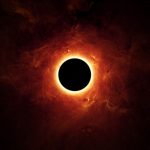We have the tendency to think of stars as the objects that produce the most light in the Universe, while moons, planets, gas, dust and rocks reflect this starlight. But it has been noticed that stars reflect light, as well.
The amount of reflected light is microscopic compared to the immense amount’s stars generate in the first place, which is why this phenomenon hasn’t been noticed before.
A new study on binary stars was the source of this revelation. A binary star is a system consisting of two stars orbiting around their common barycenter, each reflecting a small amount of the other’s light.

Spica also designated a Virginis, is the brightest object in the constellation of Virgo and located around 250 light-years away from the Sun. The two stats are so hot and close together, that they cannot be visually resolved individually.
Recently a team of astronomers have found that orientation of its wave or the polarization of the light varies as the two stars orbit.
Light that travels directly is unpolarized, wavering along multiple planes simultaneously. The light becomes polarized and oscillates along just one plane when it’s reflected off a nonmetallic surface.
The polarized light observation done by the team indicates that reflection is occurring from Spica, therefore they deployed some computer models to further examine this incident.
Jeremy Bailey, physicist of the University of New South Wales in Australia claimed that they were able to determine the amount of polarization was exactly that predicted for a reflected light model.
Their modelling showed that that stars are quite poor reflectors of light. The Sun, for instance, reflects less than 0.1 percent of the light falling on it.
The physicist mentioned that the amount of reflection increases to few per cent for the hotter stars such as the components of Spica, with temperatures of 20,000 to 25,000 Kelvin. The total amount of reflected light coming from the Spica system is still very small.
The researchers said even though the total of reflected light is only a few percent of the incident light, it can be easily discerned due to its high levels of polarization.

The study also revealed details about the binary star systems. For example, the polarization of Spica confirmed that the system’s orbit is clockwise – which is consistent with previous studies. Bailey noted that it could be used to determine the masses of the stars in a binary.
It won’t be very helpful with single stats as they don’t tend to be close enough to another light source. Any light they are reflecting is for from very far away distance and not enough of it to be useful or detectable.
However, majority of stars have binary companions – as many as 85 percent. Once upon a time, the sun had a binary twin, although disruptions of binary pairs are common. Astronomer believe that majority of stars are born in pairs but a few of them lose their twins.
Meaning that the study of binary pairs is fundamental to the study of stars in general.
To further their research, the team will be turning their polarimeters to other binary stars, to test the techniques on other systems and develop a new way of studying them.
Baily stated they expect it to work even better for hotter stars and could be ued to find binary systems and study binary star properties and orbits.




